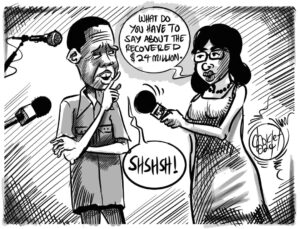Zesco says Zambia has already started receiving power from Eskom, but some challenges in the wheeling process make it hard to receive the full 300MW which was paid for.
And Zesco says despite not having a firm agreement with Eskom, the utility is confident that Zambia will still receive 300MW of electricity since most industries in South Africa are on recess.
Meanwhile, Zesco has warned that there is a risk of Kariba North Bank closing down due to the depleted water levels currently obtaining at the Kariba Dam.
On Thursday, Eskom said the power export deal with Zesco was signed two weeks ago but the commencement of supply would be dependent on whether or not South Africa’s utility had excess production.
At a media briefing held jointly with South African President Cyril Rhamaposa, who cut short his state visit to Egypt to attend to the power crisis, Eskom’s chief operating officer Jan Oberholzer told the media that the contract signed with Zesco was “non-firm”.
“The question, do we export any power, we have contracts with ZEZA that we have signed and we have also signed with Zesco, ZEZA of Zimbabwe and Zesco of Zambia. And yes we do export specifically to Zimbabwe at this time, I don’t know if we have started with Zesco but I have signed contract about two weeks ago, but I need to make it very clear, it is non firm power, it is important to understand. If Eskom needs the power, we don’t provide the power, we don’t export the power, that is important to understand. So the contracts have been signed as non firm,” said Oberholzer.
But speaking during a media briefing, Thursday, Zesco board chairperson Mbita Chitala insisted that the power imports had began, but explained why Zambia wasn’t receiving the full 300MW in some instances.
“Zesco, with the help of government, paid for the importation of power from Eskom of South Africa which began on 22 November, 2019. However, Zesco continues to face challenges in importing the full 300 MW from time to time because of the limited availability of the wheeling path during off peak periods. As Zesco, Nam power of Namibia and ZETDC of Zimbabwe are also major power importers from Eskom South Africa due to the power deficit affecting the entire region. So we are competing on wheeling the power to come to our country. Imports continue coming in. These imports, so far we have paid for one month, we keep observing the water levels for the other plants that we have and do calculations and see if we should make another payment for the second month. So that is under discussion and we will let you know as soon as it is concluded, but it is a possibility, that’s what I can say at the moment in terms of imports,” Chitala said.
Chitala also wondered why Maamba Collieries was always facing mechanical problems when they were supposedly using a new plant.
“Yes, that company is owned by Nava Bharat Pte. Limited and ZCCM –IH also holds 35 per cent and I think it’s just for you colleagues in the media to go over there and ask why are their machines are always breaking down, because they are supposed to be new and there must be warranties on those machines and that has been a big challenge for us, every other day, the machine, their boilers [are] down, we don’t know why, it’s not because we don’t pay them because all our Kalumbila money which we get, we have assigned all that money to them which is about US$8 million, everything from Zesco. And that’s sufficient to meet all their costs and even service their machines, so you go to them and ask them why are their machines are always foundering?” asked Chitala.
And speaking at the same event, Zesco director of corporate affairs Patrick Mwila said despite not having a firm agreement with Eskom, he was confident that Zambia would still get the amount of electricity paid for because most industries in South Africa were on recess.
“Obviously, we would have loved a firm agreement with Eskom, they determined that they would prefer a non-firm agreement, that is beyond us. And obviously they have to manage their situation as well because they have mentioned that they have started load shedding in South Africa, which is true, however I would say that our statement, I based on experience. We know the projections, and we have a lot of data about the SAPP region. So we know the amount of power that they trade usually and we know that right about this time as we start approaching Christmas, that was our statement, we do anticipate that a lot of industry goes on recess and it is an anticipation based on our historical records. We are not trying to contradict that South Africa is going through a challenge but we know the amounts of power they are talking about in South Africa. They are talking of 50,000MW, that’s what their installed base is so when they have a problem it’s very different from our problem. So giving us 300MW in off peak when their industry are on recess may not be as challenging as we think,” Mwila said.
Meanwhile, Mwila said the water utilization at the Kariba North Bank had exceeded the allocation given by the Zambezi River Authority it risks closure.
“We have the Kafue Gorge reservoir, the water levels are stabilizing, what we mean is that there is a dam just next to the Kafue Gorge power station, a smaller one than Itezhi-tezhi, the main reservoir is Itezhi-tezhi but there is a local one just next to the power station. We have seen the water levels beginning to stabilize. At Kariba north bank, the water utilization has exceeded the allocation. So what it means is that the little that we are able to generate from Kariba is essentially outside the bounds of what we were given by the Zambezi River Authority in charge of the dam. So essentially, we may be going into what we call the penalty situation because we have exceeded what was allocated. So following this hydrological situation, the current deficit is currently standing at about 810MW and the factors affecting this deficit is that there is a forecast power system demand of 1900 MW, now, the maximum as you might all be aware from our previous presentations sits at 2300MW,” explained Mwila.
“The best that the two countries, Zambia and Zimbabwe, can do is to do what is in our control which is to conserve the little water that is there because we can see that the centimeters to rock bottom is very little and it’s standard practice not to go to rock bottom because there are other risks that it could lead to. So what we are doing is that we are relying less and less on the Kariba so that we can allow it to build up. So is there a risk of stopping completely, I would say that in terms of risk analysis, yes, there is always a risk. It is a risk and this is why we are trying to manage it by saying let’s use less and that’s why the message has been to all of you and our consumers out there, let’s conserve the little we have.”
Mwila said Zesco was working to release a new load shedding time table next week.












